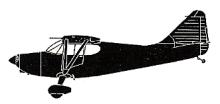
ASN Wikibase Occurrence # 195436
This information is added by users of ASN. Neither ASN nor the Flight Safety Foundation are responsible for the completeness or correctness of this information.
If you feel this information is incomplete or incorrect, you can submit corrected information.
| Date: | Tuesday 16 May 2017 |
| Time: | 20:30 |
| Type: |  Stinson 108-2 |
| Owner/operator: | Private |
| Registration: | N9366K |
| MSN: | 108-2366 |
| Year of manufacture: | 1947 |
| Total airframe hrs: | 1125 hours |
| Engine model: | Franklin 6A4-165-B3 |
| Fatalities: | Fatalities: 0 / Occupants: 1 |
| Aircraft damage: | Substantial |
| Category: | Accident |
| Location: | Eagleswood, NJ near Eagles Nest Airport (31E) -
 United States of America United States of America
|
| Phase: | Landing |
| Nature: | Private |
| Departure airport: | West Creek, NJ (31E) |
| Frederick Municipal Airport, MD (FDK/KFDK) | |
| Investigating agency: | NTSB |
| Confidence Rating: |
The private pilot reported that, while en route on a cross-country flight, the engine began to “shake.” The pilot attempted to return to the airport; however, the engine experienced a total loss of power. The pilot subsequently initiated an emergency descent; however, the airplane struck trees and terrain about 1 mile from the approach end of the runway.
The crankshaft and remaining cylinders remained intact, and the engine crankshaft rotated smoothly when the propeller was turned by hand. The No. 4 cylinder’s exhaust pushrod shroud and exhaust pushrod were both bent. An examination of the engine revealed that the No. 4 cylinder was fracture-separated from the crankcase. The piston, sections of the No. 4 cylinder, and sections of the crankcase were missing. The No. 4 exhaust valve stem was fractured about halfway along its length, and the fracture surface was consistent with reverse bending fatigue crack propagation, which typically results from a stuck valve. The lower half of the stem and face were missing. The No. 4 exhaust valve guide clearance was excessive, and the valve’s guide and tip area contained carbon deposits. The cylinder walls contained circular gouges consistent with the exhaust valve face diameter. It is likely that the carbon deposits on the valve stem resulted in the valve getting stuck, which initiated the reverse bending fatigue crack and led to the exhaust valve face stem fracturing and dropping into the cylinder and the subsequent catastrophic engine failure. The engine maintenance records were incomplete and prevented a determination of when the last clearance check of the No. 4 cylinder was performed or when it was last overhauled/replaced.
Probable Cause: A total loss of engine power due to the No. 4 cylinder’s exhaust valve getting stuck and the subsequent fracturing of the valve face stem.
Accident investigation:
 |
|
Sources:
NTSB
FAA register: http://registry.faa.gov/aircraftinquiry/NNum_Results.aspx?NNumbertxt=N9366K
Location
Images:

Photo: FAA
Revision history:
| Date/time | Contributor | Updates |
|---|---|---|
| 17-May-2017 07:39 | Rumbachtaler | Added |
| 17-May-2017 14:59 | Geno | Updated [Registration, Cn, Other fatalities, Location, Phase, Destination airport, Source, Narrative] |
| 13-Jun-2017 17:12 | Geno | Updated [Source] |
| 10-Apr-2019 12:35 | ASN Update Bot | Updated [Time, Departure airport, Destination airport, Source, Narrative, Accident report, ] |
| 10-Apr-2019 12:52 | harro | Updated [Destination airport, Source, Narrative, Photo] |
Corrections or additions? ... Edit this accident description
The Aviation Safety Network is an exclusive service provided by:


 ©2024 Flight Safety Foundation
©2024 Flight Safety Foundation